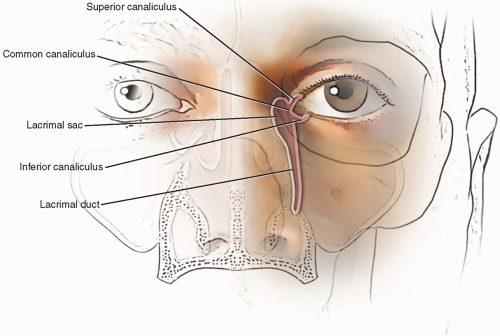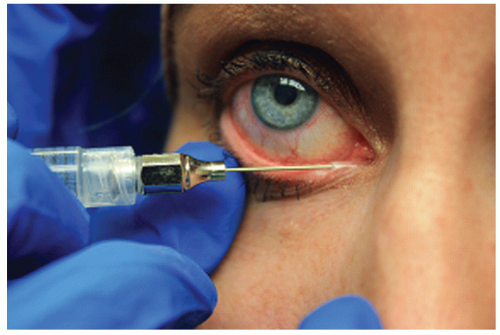Technique for Endoscopic Dacryocystorhinostomy (DCR)
Todd T. Kingdom
Vikram D. Durairaj
INTRODUCTION
Historically most of the surgery for nasolacrimal duct obstruction (NLDO) has been performed through external techniques with excellent results. Intranasal techniques for dacryocystorhinostomy (DCR) were introduced in the early 1900s, and the modern endonasal endoscopic technique was first described in the late 1980s. However, acceptance of transnasal approaches had been guarded due to inconsistent success rates. Poor visualization, limited understanding of the intranasal anatomy, and suboptimal surgical instrumentation were important factors contributing to these inferior outcomes. Advances in technology and growth in clinical experience have addressed these issues.
Reported results in both the ophthalmology and otolaryngology literature now validate the endoscopic approach to DCR with success rates comparable to or even exceeding the traditional external techniques. The advantages of endoscopic DCR include the absence of a skin incision and a scar, preservation of the pump mechanism of the orbicularis oculi muscle, less disruption of the anatomy of the medial canthus, decreased operating time, decreased intraoperative bleeding, and the ability to concurrently address abnormalities of the nasal cavity or paranasal sinus.
HISTORY
The most common clinical presentation for patients requiring DCR is the complaint of excessive tearing with or without a history of episodes of acute dacryocystitis. Acquired tearing results from either hypersecretion of tears (lacrimation) or impairment of drainage (epiphora). Acquired NLDO presents with epiphora and/or infection. Epiphora can be unilateral or bilateral and can be constant or intermittent. It can be associated with midfacial trauma, rhinitis, rhinosinusitis, previous nasal or sinus surgery, systemic inflammatory disease, stenosis of the lacrimal punctum or canaliculus, and previous episodes of inflammation of the lacrimal sac.
Known associations with NLDO:
Lacrimal sac inflammation
Midfacial trauma
Previous with radioactive iodine treatment
Rhinitis/rhinosinusitis
Sarcoidosis
Wegener’s granulomatosis
PHYSICAL EXAMINATION
A team approach to the surgical treatment of NLDO is ideal. Both the otolaryngologist and the ophthalmologist must examine the patient in preparation for surgery.
Rhinologic Evaluation
Complete and thorough nasal endoscopy should be performed in all patients presenting with NLDO. Rhinitis, rhinosinusitis, nasal polyposis, nasal mass, severe deformities of the nasal septum, and prior endonasal surgery are possible important factors contributing to NLDO. The surgeon must also assess endoscopic surgical access during this preoperative examination. Correction of septal deviations and middle turbinate anomalies might be required to fully access the surgical target. Ideally, the superior insertion of the middle turbinate, the middle meatus, the uncinate process, and maxillary line should be readily visible for proper access.
Assess endoscopic surgical access
Evaluate the anatomy of the middle turbinate
Identify septal deviation
Identify the sinonasal pathology
Visualize the superior insertion of middle turbinate and maxillary line
Ophthalmologic Evaluation
NLDO can be confirmed by several lacrimal diagnostic tests including the dye disappearance test, lacrimal drainage system irrigation and probing, scintigraphy, and contrast dacryocystography. Figure 30.1 demonstrates the important anatomy of the nasolacrimal system. Persistence of dye or asymmetric clearance after instillation of 2% fluorescein solution in the conjunctival cul-de-sac after 5 minutes indicates decreased outflow. Irrigation of the lacrimal system with a blunt-tipped 23-gauge irrigating cannula with reflux through the opposite punctum indicates either partial or complete NLDO (Fig. 30.2). Scintigraphy using gamma ray-emitting
radionucleotides can be used to evaluate physiologic flow, and contrast dacryocystography can radiologically define lacrimal sac anatomy, though these studies are rarely used.
radionucleotides can be used to evaluate physiologic flow, and contrast dacryocystography can radiologically define lacrimal sac anatomy, though these studies are rarely used.
Commonly Used Tests:
Disappearance of the dye
Irrigation of the lacrimal system
Probing of the lacrimal system
Uncommonly Used Tests:
Contrast dacryocystography
Scintigraphy
INDICATIONS
Epiphora
Obstruction of the nasolacrimal duct
Recurrent acute or chronic dacryocystorhinitis
Rule out neoplasm of the lacrimal system
CONTRAINDICATIONS
No absolute contraindications
Relative contraindications—standard perioperative issues
PREOPERATIVE PLANNING
Physical Examination
Nasal endoscopy
Evaluation of the lacrimal system
Imaging
None typically
Exception: distorted midfacial and/or sinonasal bony anatomy
SURGICAL TECHNIQUE
The endoscopic DCR technique is typically performed under general anesthesia, and the setup is approached in the same fashion as routine endoscopic sinus surgery. Topical decongestion of the nasal mucosa with oxymetazoline is carried out in the preoperative holding area followed in the operating room by intranasal placement of pledgets soaked in 1:1,000 parts epinephrine. Intraoperative surgical navigation is not routinely used. The initial step is to identify the key endoscopic surgical landmarks: (1) the maxillary line, (2) the uncinate process, and (3) the superior attachment of the middle turbinate. The maxillary line corresponds to the suture line between the frontal process of the maxilla and the lacrimal bone, which runs vertically through the lacrimal fossa. This serves as a consistent endoscopic landmark for the lacrimal sac (Figs. 30.3 and 30.4).
Stay updated, free articles. Join our Telegram channel

Full access? Get Clinical Tree




